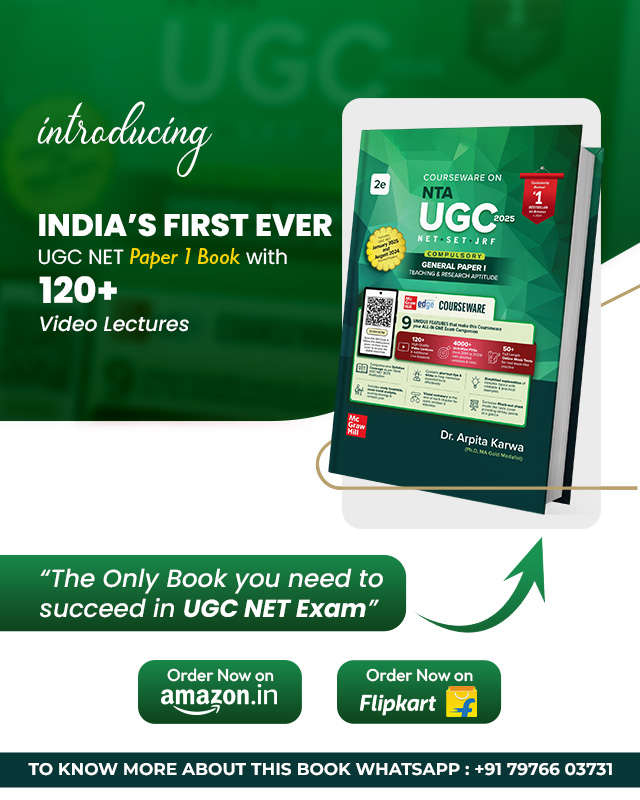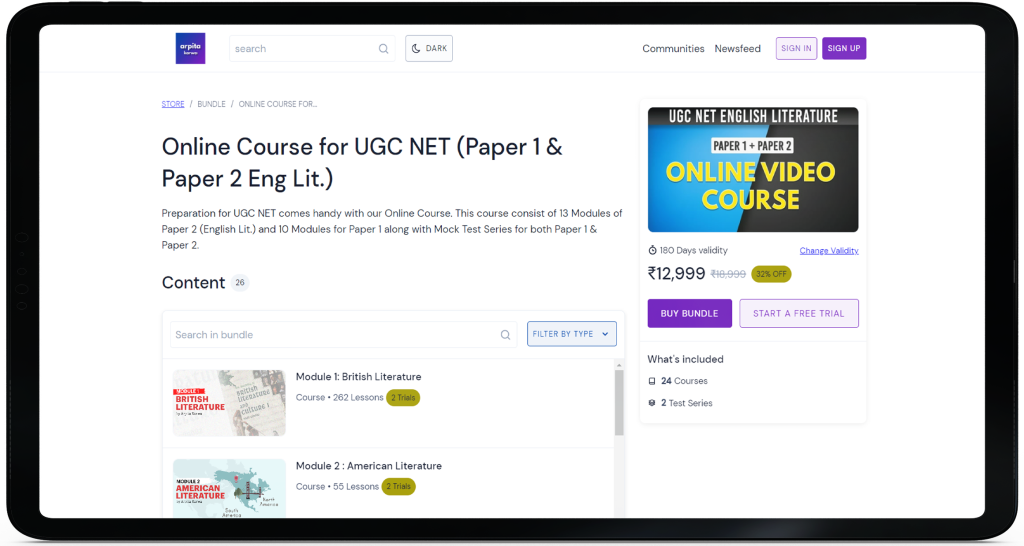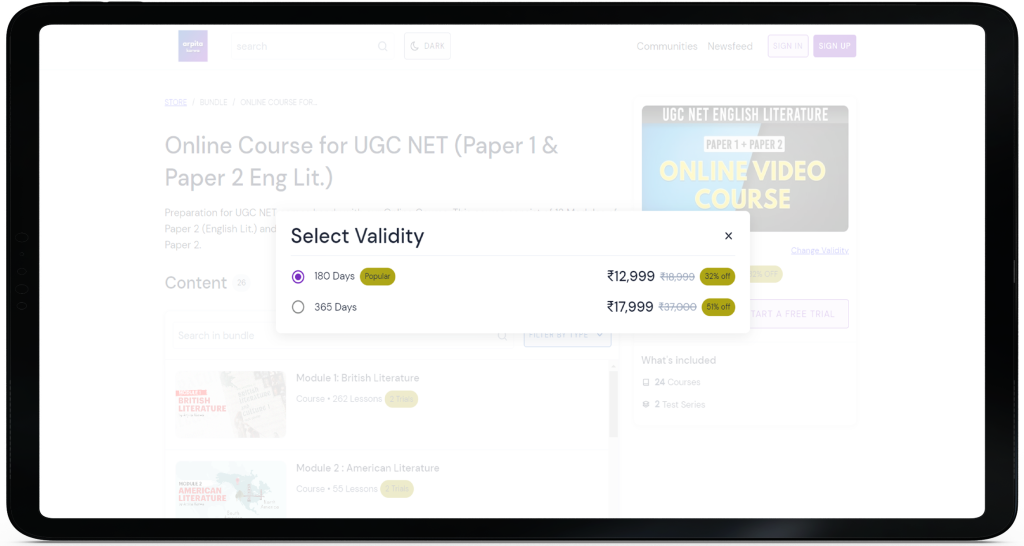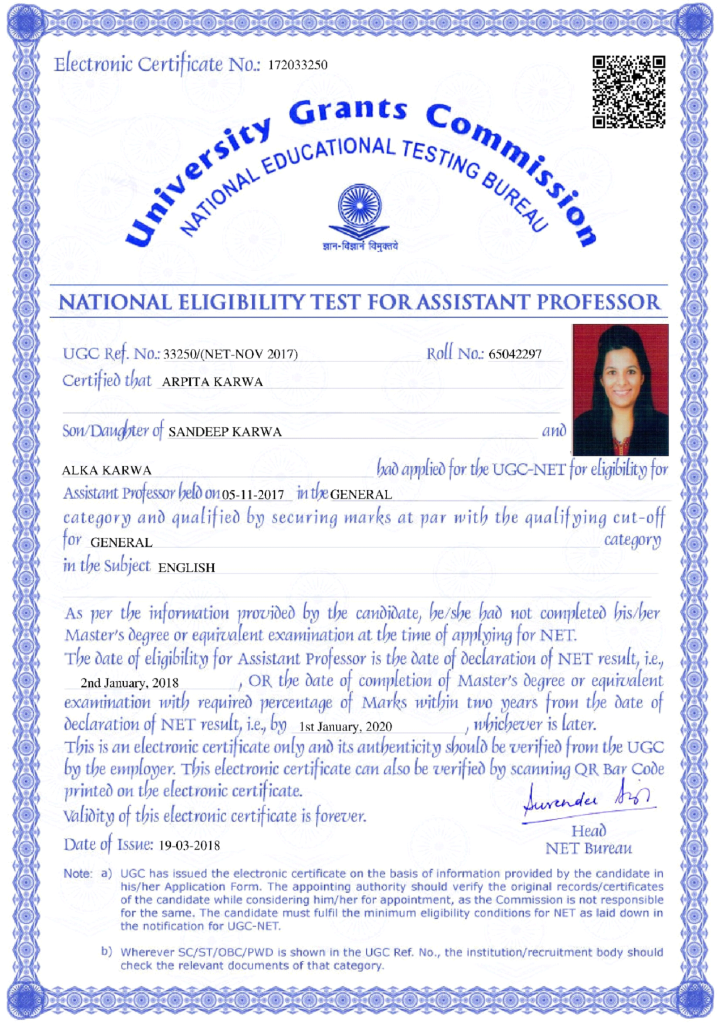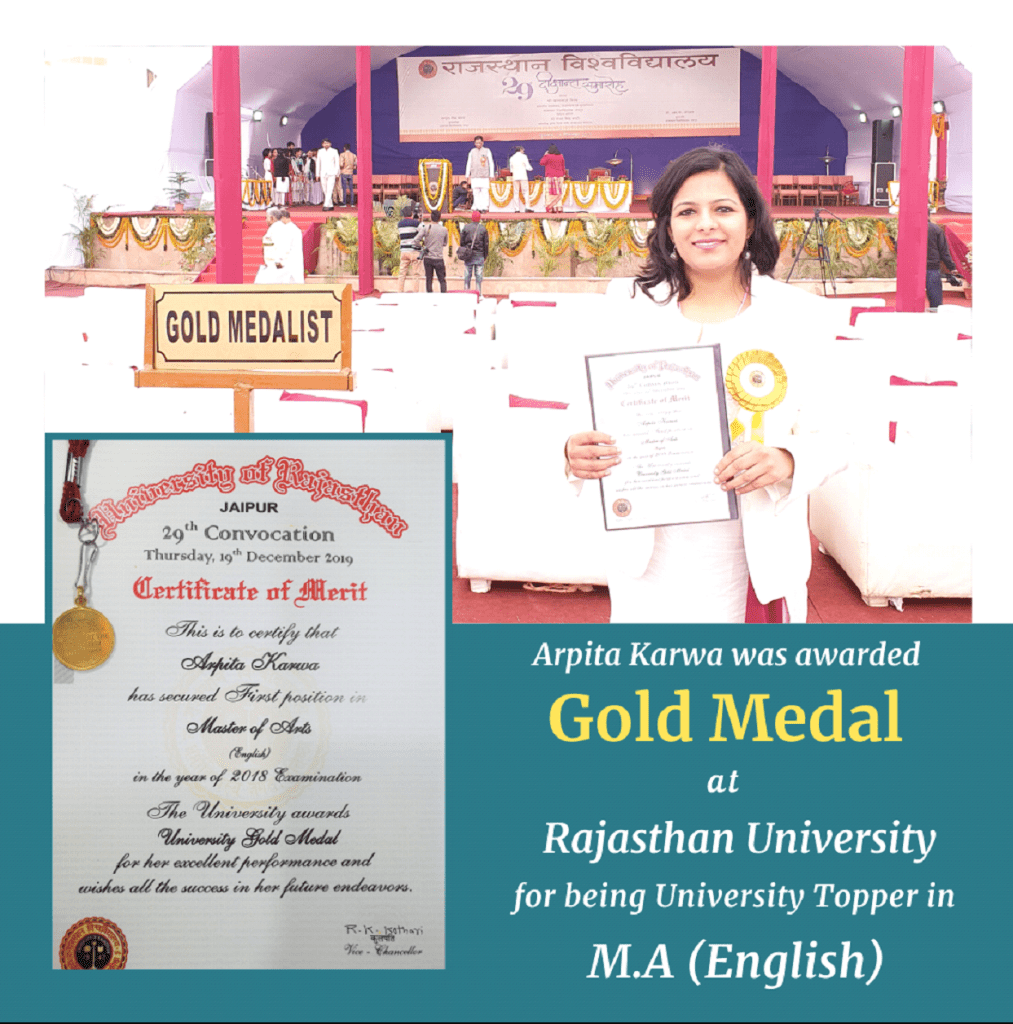UNIVERSITY OF DELHI M.A. ENGLISH, ENTRANCE EXAM 2019
June 19, 2023 2023-12-11 18:35UNIVERSITY OF DELHI M.A. ENGLISH, ENTRANCE EXAM 2019
University of Delhi M.A. English, Entrance Exam 2019
Directions (Qs. Nos. 1-4): Read the passage given below and select the most appropriate option given in each case.
Mine, as becomes a woman, is a modest domestic programme merely to restore India to her true position as supreme mistress in her own home, sole guardian of her vast resources, and sole dispenser of her own rich hospitalities as a loyal daughter of Bharat Mata.
Therefore, it will be my lovely, though difficult task through the coming year to try to set my mother’s house in order: to reconcile the tragic quarrels that threaten the integrity of her old history, joint family, the life of diverse communities and creeds, and to find an adequate place, purpose and recognition, alike for the guests and the strangers within her gates.
Q.1) This extract seeks to link______.
[1] Indian aesthetics and Indian history
[2] Indian jingoism and British imperialism
[3] Indian nationalism and Indian feminism
[4] Indian nationalism and Indian history
Answer: Indian nationalism and Indian feminism
Q.2) The centrality of domestic discourse within the freedom struggle may be seen from_____.
[1] the use of domestic space as an alibi within which to domicile nationalistic fervour
[2] the use of domestic space as a trope within which to domicile nationalistic fervour
[3] the use of domestic space as a pretext within which to domicile nationalistic fervour
[4] the use of domestic space as an excuse within which to domicile nationalistic fervor
Answer: the use of domestic space as an alibi within which to domicile nationalistic fervour
Q.3) The movement from domestic space to public space is Signalled by the phrase______.
[1] ‘my mother’s house in order’
[2] ‘to reconcile the tragic quarrels’
[3] ‘the mightiest of her children and foster- children’
[4] to find an adequate place, purpose and recognition’
Answer: to find an adequate place, purpose and recognition’
Q.4) The use of domestic idiom to reconfigure public space suggests that early Indian feminism_____.
[1] embraced the opportunity offered by the freedom struggle to seek a new safety- valve for itself
[2] embraced the opportunity offered by the freedom struggle to seek a new space for advertising itself
[3] embraced the opportunity offered by the freedom struggle to seek a new purpose for itself
[4] embraced the opportunity offered by the freedom struggle to seek a new constituency for itself
Answer: embraced the opportunity offered by the freedom struggle to seek a new purpose for itself
Directions (Qs. Nos. 5-9): Fill in the blanks with the most appropriate option from the choices given below:
“With the focus on the effect of a text on the recipient or reader, ___(a)___ theory is obviously opposed to ___(b)___ dogma of affective fallacy, which demands an interpretation free of ___(c)___ by the reader. Reader-centered approaches examine the readership of a text and investigate why, where, and when it is ___(d)___. They also examine certain ___(e)___ practices of social, ethnic, or national groups. Many of these investigations also deal with and try to explain the physiological aspect of the actual reading process.”
Q.5) most appropriate option for the blank (d).
[1] thought
[2] written
[3] examined
[4] read
Answer: examined
Q.6) Most appropriate option for the blank (e).
[1] assimilating
[2] writing
[3] addressing
[4] reading
Answer: reading
Q.7) Most appropriate option for the blank (c).
[1] historical contributions
[2] objective contributions
[3] sociological contributions
[4] subjective contributions
Answer: objective contributions
Q.8) Most appropriate option for the blank (b).
[1] Romantic criticism’s
[2] New criticism’s
[3] Psychoanalytical criticism’s
[4] Neo-classical criticism’s
Answer: New criticism’s
Q.9) Most appropriate option for the blank (a).
[1] Reception
[2] Associationist
[3] Rejection
[4] Impersonal
Answer: Reception
Directions (Qs. Nos. 10-16): Read the passage given below and select the most appropriate option given in each case. The passage is about the Japanese adaptation of Macbeth on screen by Akira Kurosawa.
The scene: 11th or 12th century Japan, a time of fire, earthquake, pestilence, banditry, war, all the four horsemen. The movie opens with an overpowering rainstorm at the Rashomon Gate, the main gate to the city of Kyoto. The gate is in ruins, and we are told that the city is as well. The gate makes a powerful symbol. It is both inside and outside the city. Inside is what is supposedly safe and civilized. Outside is the forest, a place (traditionally) of gods and demons, but also, we are told, where “men lose their way.” The gate reminds us of civilization, but it is in a state of ruin. A gate also symbolizes a beginning or an end-think of January and Janus, the double-faced god of gates. Think too of a gate as a symbol for birth, in both an anatomical and a metaphorical sense. And death. This film begins with death and ends with a baby, all at this gate. No wonder this gate was the one hugely expensive item Kurosawa insisted on in his budget. No wonder Kurosawa named his movie for the gate.
Q.10) Which of the following do not fit into the reference to the Four Horsemen of the Apocalypse?
[1] pestilence
[2] banditry
[3] war
[4] destruction of the gate by fire
Answer: destruction of the gate by fire
Q.11) The name of the adaptation of Macbeth on screen by Akira Kurosawa is_____.
[1] Ran
[2] The Seventh Seal
[3] Throne of Blood
[4] Rashomon
Answer: Rashomon
Q.12) The reference to Janus, the God of gates indicates________.
[1] the functioning of the gate as a barrier
[2] the solidification of the binaries by the presence of the gate
[3] the liminal space that the gate occupies
[4] None of these
Answer: the liminal space that the gate occupies
Q.13) Identify a possible framing device used in the narrative:
[1] Rashomon Gate
[2] Fire
[3] Baby
[4] Forest
Answer: Rashomon Gate
Q.14) Identify the statements that do not connect Rashomon and Macbeth:
[1] The civilization is in ruins.
[2] Men do not lose their way inside the gate.
[3] The gate is in ruins.
[4] The city is in ruins.
Answer: Men do not lose their way inside the gate
Q.15) Identify the binaries alluded to in the narrative:
[1] City and Suburbs
[2] Gods and Demons
[3] Gods and Human
[4] Nature and Culture
Answer: Nature and Culture
Q.16) How was the gate used in the adaptation by Akira Kurosawa?
[1] It was used to show his greatness as it was the one hugely expensive item Kurosawa insisted on in his budget.
[2] It was used as a mere prop in the adaptation.
[3] It was used in the adaptation both literally and symbolically.
[4] It was used as a powerful symbol of anatomical birth.
Answer: It was used in the adaptation both literally and symbolically.
Directions (Q. No. 17-19): Read the passage given below and select the most appropriate option given in each case.
To be sick is to enjoy monarchal prerogatives. Compare the silent tread, and quiet ministry, almost by the eye only, with which he is served – with the careless demeanour, the unceremonious goings in and out (slapping of doors, or leaving them open) of the very same attendants, when he is getting a little better – and you will confess, that from the bed of sickness (throne let me rather call it) to the elbow chair of convalescence, is a fall from dignity, amounting to a deposition.
Q.17) The above extract bears the impression of______.
[1] Romantic Writing
[2] Neoclassical Writing
[3] Elizabethan Writing
[4] Victorian Writing
Answer: Romantic Writing
Q.18) Identity the type of narrator of the given extract.
[1] Objective narrator
[2] Self-conscious narrator.
[3] Intrusive narrator
[4] Limited narrator
Answer: Intrusive narrator
Q.19) Identify the tone of the passage.
[1] Authoritative tone
[2] Pessimistic tone.
[3] Arrogant tone
[4] Conversational tone.
Answer: Conversational tone
Directions (Q. No. 20-23): Read the excerpt given below and select the most appropriate option given in each case.
Irish poets, learn your trade, Sing whatever is well made,
Scorn the sort now growing up, All out of shape from toe to top,
Their unremembering hearts and heads, Base-born products of base beds.
Sing the peasantry, and then Hard-riding country gentlemen,
The holiness of monks, and after Porter-drinkers’ randy laughter;
Sing the lords and ladies gay That were beaten into the clay
Through seven heroic centuries;
Cast your mind on other days
That we in coming days may be
Still the indomitable Irishry.
Q.20) The last three lines of the stanza look to the______.
[1] future to shape the present
[2] future to shape the past
[3] past to shape the future
[4] past to shape the present
Answer: past to shape the future
Q.21) By referring to poetry as a “trade” the poet implies that_______.
[1] poetry is written for the marketplace
[2] poetry is written to be bought and sold
[3] the poets have pecuniary motives in writing poetry
[4] writing poetry requires skill
Answer: writing poetry requires skill
Q.22) The lines above can be read as______.
[1] an exercise in nativism
[2] an exercise in nostalgia
[3] an attempt to reshape Ireland
[4] an attempt to reshape poetry
Answer: an attempt to reshape poetry
Q.23) The contrast in the stanza is between______.
[1] “the indomitable Irishry” and “base beds”
[2] the poetry of the past and the present
[3] the poetry of peasants and that of gentlemen
[4] the “holiness of monks” and lesbians
Answer: “the indomitable Irishry” and “base beds”
Directions (Q. No. 24 and 25): Following question is based on Arthur Miller’s 1949 play “Death of a Salesman”. Select the most appropriate option given in each case.
Q.24) Which category does the play belong to?
[1] A Murder Mystery
[2] A Shakespearean Tragedy
[3] An Existentialist Play
[4] An Epic Theatre
Answer: An Existentialist Play
Q.25) The salesman referred to in the title dies of_____.
[1] alcoholism
[2] despair because he is unable to keep up with market forces which determine his profession
[3] a road accident
[4] a heart attack
Answer: despair because he is unable to keep up with market forces which determine his profession
Directions (Q. No. 26-30): Read the passage given below and select the most appropriate option given in each case.
When it comes to creating poetic comparisons, there’s no match for my mother. Of course, I know Ma loves poetry. At one time, so it is said, she used to write poetry as well. After her marriage, she didn’t write any more. Perhaps that because of my father. Baba was a doctor. When he was involved in World War II, he had earned the title of ‘Major’ that would be added before his name. The war had probably drained him of all passion. He had not liked the fact that Ma wrote poetry. Ma used to treat Baba with deference. Baba had married rather late in life, long after he came back from the war. The difference in age between him and Ma was considerable.
Ma repeated, ‘Why, Khoka, not up yet?! I wanted you to watch the morning mist with me.” ‘I’ll be up right away Ma, in a couple of minutes.’
I kept my face covered with the quilt. All the same, I clearly saw my mother move around in the room, a dark green shawl wrapped around her body. The half darkness of dawn enveloping her.
Ma sits down on the bed, next to me and places her moist, covered river, my dear. ‘If only I could have shown it to you!’
Taking my mother’s hand in my fist, I turn over on my side; ‘Don’t be upset, Ma. I’ll go see that misty rivers of Yours.”
Q.26) Which of the following statement(s) allude(s) to the fact that the family is patriarchal?
(A) After her marriage, she didn’t write any more.
(B) Ma used to treat Baba with deference.
(C) Of course, I know Ma loves poetry.
(D) ‘Don’t be upset, Ma. I’ll go see that misty rivers of Yours.”
[1] (C) and (D)
[2] Only (A)
[3] (A) and (B)
[4] (A), (B) and (C)
Answer: (A) and (B)
Q.27) Who used to write poetry?
[1] All of these
[2] The Mother of the narrator
[3] The narrator
[4] The Father of the narrator
Answer: The Mother of the narrator
Q.28) Identify the genre used by the author.
[1] Memoir
[2] Social commentary
[3] All of these
[4] Life Writing
Answer: All of these
Q.29) From the following sentences identify the one(s) that point(s) to a possible case of prejudice and identity crisis:
(A) He had not liked the fact that Ma wrote poetry.
(B) At one time, so it is said, she used to write poetry as well.
(C)The difference in age between him and Ma was considerable.
(D) After her marriage, she didn’t write any more.
[1] Only (A)
[2] (A) and (D)
[3] (A), (B) and (C)
[4] All of these
Answer: (A) and (D)
Q.30) ‘Don’t be upset, Ma. I’ll go see that misty rivers of Yours.’ Pick the most suitable inference(s) given below.
(A) Narrator is consoling the mother.
(B) Narrator is empathising with the mother.
(C) Narrator’s empathy towards another woman.
(D) Mutual understanding between the child and the mother.
[1] (B) and (D)
[2] Only (A)
[3] (A), (B) and (C)
[4] (A), (B) and (D)
Answer: (A), (B) and (D)
Directions (Q. No. 31-35): Read the passage given below and select the most appropriate option given in each case.
The one night I found myself thinking of Cheechum and of my childhood. I remember her saying, “you can have anything you want if you want it bad enough.” I got up and went for a walk and suddenly it was all so clear. I could quit if I made up my mind. I could leave and work on a farm, I could scrub floors – anything – I didn’t have to stay here. I walked back to our room and cleaned myself up as best as I could, and then went to a small coffee shop on West Hastings and found a girl who had tried to befriend me once at Lil’s. She had gone straight and was on some sort of religious kick. I told her I wanted to kick and I needed her help. She took me home and again I went through withdrawal.
Although it was worse than the first time, in a way it was easier, because this time my Cheechum was with me the whole time. I could feel her presence in the room with me and I wasn’t afraid.
Q.31) From the following sentences identify the one(s) that point to a possible case of substance abuse and attempt(s) at rehabilitation by the narrator.
(A) I told her I wanted to kick and I needed her help.
(B) She had gone straight and was on some sort of religious kick.
(C) She took me home and again I went through withdrawal.
(D) I could leave and work on a farm, I could scrub floors – anything – I didn’t have to stay here.
[1] Only (A)
[2] Only (A) and (B)
[3] (A), (B) and (C)
[4] (A), (B) and (D)
Answer: (A), (B) and (C)
Q.32) Identify the genre used by the author.
[1] Autobiography
[2] Biography
[3] All of these
[4] Fairy Tale
Answer: Autobiography
Q.33) Identify the narrative strategy used by the author.
[1] Flash forward
[2] Linear narrative
[3] Stream of consciousness
[4] Frame story
Answer: Flash forward
Q.34) What kind of a novel is this?
(A) Bildungsroman
(B) Novel of formation
(C) Novel of education
(D) Dystopian novel
Codes:
[1] Only (A)
[2] Only (A) and (B)
[3] Only (D)
[4] (A), (B) and (C)
Answer: (A), (B) and (C)
Q.35) “You can have anything you want if you want it bad enough.” The speaker of this line is_______.
[1] Cheechum
[2] Lil
[3] Speaker
[4] None of these
Answer: Cheechum
Q.36) The ‘uncrossable line’ refers to the_______.
[1] difference of level of emotion
[2] distance between the worlds of the living and the dead
[3] borders between countries in which the lovers reside
[4] None of these
Answer: distance between the worlds of the living and the dead
Directions (Q.No. 37-39): Read the excerpt given below and select the most appropriate option given in each case.
Under the blue skies of her native land
She languished and began to fade…
Until surely there flew without a sound
Above me, her young shade.
But there stretches between us an uncrossable line;
In vain my feelings I tried to awaken.
The lips that brought the news were made of stone,
And I listened like a stone, unshaken.
So this is she for whom my soul once burned
In the tense and heavy fire, Obsessed, exhausted, driven out of my mind
By tenderness and desire!
Where are the torments? Where is love? Alas!
For the unreturning days’
Sweet memory and for the poor credulous
Shade, I find no lament, no tears.
Q.37) The poet is sure that the spirit has flown above him because________.
(A) she had such deep love for him
(B) she was a good spirit who had gone to heaven
(C) the lover is living on the earth and there is an uncrossable line between the dead and the living
[1] (B) and (C)
[2] (A) and (C)
[3] (A) and (B)
[4] All of these
Answer: All of these
Q.38) In the above lines the poet expresses a man’s feelings at the death of his_____.
[1] mother
[2] sister
[3] beloved
[4] child
Answer: beloved
Q.39) “And I Listened like a stone unshaken.” Identify the figure of speech used here.
[1] Hyperbole
[2] Metaphor
[3] Simile
[4] Personification
Answer: Simile
Directions (Qs. Nos. 40-42): Read the passage given below and select the most appropriate option given in each case.
It is generally better to deal by speech than by letter; and by the mediation of a third than by a man’s self. Letters are good, when a man would draw an answer by letter back again; or when it may serve for a man’s justification afterwards to produce his own letter; or where it may be danger to be interrupted, or heard by pieces. To deal in person is good, when a man’s face breedeth regard, as commonly with inferiors; or in tender cases, where a man’s eye upon the countenance of him with whom he speaketh may give him a direction how far to go; and generally, where a man will reserve to himself liberty either to disavow or to expound.
Q.40) Which one of the following assertions can be deduced from the given extract?
[1] All of these
[2] The given extract bears the impression of the Periodical essays.
[3] The central concern of the given extract is successful dealing.
[4] The author of the given extract is in a confused state of mind.
Answer: The central concern of the given extract is successful dealing
Q.41) The above extract reminds one of the writing styles of________.
[1] Francis Bacon
[2] William Hazlitt
[3] George Orwell
[4] Charles Lamb
Answer: Francis Bacon
Q.42) The author of the given extract appears to be in a_________.
[1] descriptive mood
[2] interrogative mood
[3] reflexive mood
[4] narrative mood
Answer: reflexive mood
Directions (Qs. Nos. 43-45): Read the sonnet given below and select the most appropriate option given in each case.
How do I love thee? Let me count the ways.
I love thee to the depth and breadth and height
My soul can reach, when feeling out of sight
For the ends of being and ideal grace.
I love thee to the level of every day’s
Most quiet need, by sun and candle-light.
I love thee freely, as men strive for right.
I love thee purely, as they turn from praise.
I love thee with the passion put to use
In my old griefs, and with my childhood’s faith.
I love thee with a love I seemed to lose With my lost saints.
I love thee with the breath, Smiles, tears, of all my life;
and, if God choose, I shall but love thee better after death.
Q.43) The first six lines of the sonnet derive their force from the way in which they discuss______.
[1] the lover and the beloved in terms of each other
[2] the everyday and the sublime in terms of each other
[3] life and death in terms of each other
[4] love and religion in terms of each other.
Answer: the everyday and the sublime in terms of each other
Q.44) The sonnet reveals the period of its composition in the way it_______.
[1] prioritises imagination over reason as most Romantic poems do
[2] depends upon unravelling an elaborate metaphysical conceit
[3] articulates the Victorian compromise between faith and doubt
[4] rigorously balances reason and passion in an Augustan manner
Answer: articulates the Victorian compromise between faith and doubt
Q.45) The sonnet opens with a question that is_______.
[1] hyperbolical, because it deals with imponderable values
[2] hyperbolical, because it deals with the impossible
[3] rhetorical, because it makes an impact rather than generates information
[4] rhetorical, because the rest of the poem reverses the terms of the question, but answers it
Answer: rhetorical, because the rest of the poem reverses the terms of the question, but answers it
Directions (Qs. Nos. 46-49): Read the passage given below and select the most appropriate option given in each case.
“So, this is the little woman who made the big war! “said Abraham Lincoln, on meeting the author of Uncle Tom’s Cabin?
Q.46) How, according to Lincoln, did “the little woman” make the “big war”?
[1] By writing a powerful book which made an impact on people’s minds
[2] By mobilising opinion through fiery journalism
[3] By successfully leading an army into enemy territory
[4] By skilful espionage efforts
Answer: By writing a powerful book which made an impact on people’s minds
Q.47) Which was the “big war” that he was talking about?
[1] World War I
[2] World War II
[3] The U.S. War in Afghanistan
[4] The U.S. Civil War
Answer: The U.S. Civil War
Q.48) Who was the “little woman” that Lincoln was alluding to?
[1] Harriet Jacobs
[2] Harriet Beecher Stowe
[3] Margaret Mitchell
[4] Mrs. Lincoln
Answer: Harriet Beecher Stowe
Q.49) The “big war” had a far-reaching historical impact. It resulted in_______.
[1] the secession of the southern states from the American Union
[2] the formal abolition of the institution of slavery in the United States of America
[3] the beginning of the Cold War between the U.S.A. and the Soviet Union
[4] the defeat of Abraham Lincoln in the next presidential elections
Answer: the formal abolition of the institution of slavery in the United States of America
Directions (Qs. Nos. 50-53): Read the passage given below and fill in the blanks with the most appropriate option from the choices given below:
__(a)__ criticism would say we should ask the author, and if he/she is dead, we should read biographies, diaries, or letters, until we can guess what the author might have intended. __(b)__however, disagrees. If language is not ours to process, but always__(c)__ us and comes from outside, and if poems issue from language, not from the ideas which are language’s __(d)__, there is no final answer to the question of what any particular example of language in action ultimately means.
Q.50) most appropriate option for the blank (a).
[1] New
[2] 20th century
[3] Traditional
[4] Puritan
Answer: Traditional
Q.51) most appropriate option for the blank (d).
[1] cause rather than its effect
[2] cause and effect
[3] effective cause
[4] effect rather than its cause
Answer: effect rather than its cause
Q.52) most appropriate option for the blank (b).
[1] Structuralism
[2] Poststructuralism
[3] Feminism
[4] Formalism
Answer: Poststructuralism
Q.53) most appropriate option for the blank (c).
[1] follows
[2] replaces
[3] pre-exists
[4] supersedes
Answer: pre-exists
Q.54) A supposition or proposition made at the beginning of the investigation is known as ____.
[1] Synthesis
[2] Thesis
[3] Synopsis
[4] Hypothesis
Answer: Hypothesis
Q.55) Which of the following statement best describes the imagist movement?
[1] An effort to free poetry from excessive romanticism and facile emotionalism, replacing it with a precision and clarity of imagery
[2] An attention to alternate states of consciousness and uncanny imagery
[3] The neo-platonic poetics that stresses the importance of poetry aiming to achieve its ideal “form”
[4] The resurrection of Romantic poetic sensibility
Answer: An effort to free poetry from excessive romanticism and facile emotionalism, replacing it with a precision and clarity of imagery
Q.56) Which of the following statements are true about the Elizabethan Revenge Tragedies?
(A) Rape, adultery and murder are prominent features of this category of plays.
(B) Structure of world seems mysterious and it results into a lot of cynicism.
(C) These plays underline the limitations of criminal vision.
(D) These plays present highly formalised and rather idealised picture of divine justice.
[1] (A), (C) and (D)
[2] (A), (B) and (C)
[3] (A), (B) and (D)
[4] All of these
Answer: (A), (B) and (C)
Q.57) Which of the following statement(s) is/are correct about “Tintern Abbey”?
(A) It is a central statement of the poet’s faith in the restorative and associative power of nature.
(B) It describes the development of the poet’s own love of nature.
[1] Both (A) and (B)
[2] Only (A)
[3] Only (B)
[4] None of these
Answer: Both (A) and (B)
Q.58) Which of the following statements about Jonathan Swift are true?
(A) His style is simple, direct and colloquial.
(B) His style is ornamental and rhetorical.
(C) He is a satirist.
(D) His favourite instrument is irony.
[1] (A), (C) and (D)
[2] (A), (B) and (C)
[3] All of these
[4] (B), (C) and (D)
Answer: (B), (C) and (D)
Q.59) Which of the following statement best describes Pathetic Fallacy?
[1] An incantation used to invoke a deity the supernatural.
[2] An ingenious or fanciful comparison or metaphor.
[3] A conversation or speech characterized by quick, witty comments or replies.
[4] Some human emotions or feelings being ascribed to an inanimate natural object.
Answer: Some human emotions or feelings being ascribed to an inanimate natural object.
Q.60) Which of the following play of Shakespeare observes the three unities?
[1] The Tempest
[2] Hamlet
[3] Macbeth
[4] As You Like It
Answer: The Tempest
Q.61) Which of the following is/are true about Brecht’s “Epic Theatre”?
[1] It uses songs to comment on the action.
[2] All of these
[3] It rejects Aristotelian Principles.
[4] It regards plays as a series of loosely connected scenes.
Answer: All of these
Q.62) Which of the following methods of instruction relies on Socratic method of questioning to get students to think logically about problems in the context in which they occur?
[1] Field Trip
[2] Case Study Method
[3] Laboratory Classroom
[4] Lecture Method
Answer: Case Study Method
Q.63) Which of the following is true about the Yoknapatawpha county in many of William Faulkner’s novels?
[1] It is the setting of Faulkner’s first novel
[2] It is a name derived from a Victorian town.
[3] It is a fictional county in Mississippi.
[4] It is the birth place of Faulkner.
Answer: It is a fictional county in Mississippi
Q.64) Which of the following is true about Jacobean Drama?
[1] Audience expected intense evil and intrigue.
[2] Fear of female agency breaded the need for prurient entertainment.
[3] All of these
[4] Necessity and fear became motivating force in the new world.
Answer: All of these
Q.65) Which one of the following is a closet drama?
[1] The Beggar’s Opera by John Gay
[2] Prometheus Unbound by P B Shelley
[3] Hyperion by John Keats.
[4] None of these
Answer: Prometheus Unbound by P B Shelley
Q.66) Which among the following is not a Gothic novel?
[1] The House of the Seven Gables
[2] The Mysteries of Udolpho
[3] The Ghost Map
[4] The Strange Case of Dr Jekyll and Mr Hyde
Answer: The Ghost Map
Q.67) Which among the following is the most appropriate statement about Formalist Critics?
[1] Everything outside the text is irrelevant for them because it is not static.
[2] All of these
[3] They seek a static, unchanging universal Truth within the text.
[4] They look only at the text and how well it is dressed.
Answer: All of these
Q.68) Pick the odd one out
[1] George Bernard Shaw
[2] Seamus Heaney
[3] James Joyce
[4] Saul Bellow
Answer: Seamus Heaney
Q.69) In Jonson’s Comedy of Humours, humour is used to suggest________.
(A) Obsession
(B) Quirk Of Character
(C) A Disease
(D) Madness
Codes:
[1] (C) and (D)
[2] (B) and (C)
[3] (A) and (D)
[4] (A) and (B)
Answer: (A) and (B)
Q.70) Identify the novel that outlines a feminist utopia.
[1] Virginia Woolf’s A Room of One’s Own
[2] Sally Morgan’s My Place
[3] Rokeya Sakhawat Hossain’s Sultana’s Dream
[4] Anita Nair’s The Ladies Coupe
Answer: Rokeya Sakhawat Hossain’s Sultana’s Dream
Q.71) Wordsworth in his ‘Preface to Lyrical Ballads’ advocates the choice of rustic life on the grounds that______.
(A) in rural life the essential passions of heart find a better soil to attain maturity
(B) in it our elementary feelings co-exist in a state of greater simplicity
(C) the passions of men are incorporated with the beautiful and permanent forms of nature
(D) rural life can be easily comprehended
[1] (A), (C) and (D)
[2] (A), (B) and (D)
[3] All of these
[4] (B), (C) and (D)
Answer: All of these
Q.72) Metaphysical conceit is______.
[1] a metaphor
[2] a simile
[3] a far-fetched comparison between two things
[4] a symbol of nature
Answer: a far-fetched comparison between two things
Q.73) “Ain’t I a Woman: Black Women and Feminism” is the book by Bell Hooks which argues that black women have, historically, been wary of the feminist movement. Among the following statements what is the appropriate reason for the problematic relationship of black women and feminism.
[1] Black women consider feminism to be a movement which addresses the needs of white, middle-class women only.
[2] Black women think that feminism is disruptive of family values.
[3] Black women think that feminism is anti-man.
[4] Black women think that feminism is too shrill as a movement.
Answer: Black women consider feminism to be a movement which addresses the needs of white, middle-class women only
Q.74) _______ is a controversial alternative way of analyzing literature created by literary scholar Franco Moretti.
[1] Distant Reading
[2] Close Reading
[3] Parallel Reading
[4] Unreading
Answer: Distant Reading
Q.75) Charles Lamb’s essays are famous for ______.
(A) presenting a peculiar blend of humour and pathos
(B) their objective assessment of the subject
(C) autobiographical element
(D) their ornamental language
[1] (C) and (D)
[2] (A) and (C)
[3] (A) and (B)
[4] All of these
Answer: All of these
Q.76) Who, among the following artists, was associated with Third Theatre?
[1] Badal Sircar
[2] Tom Stoppard
[3] Habib Tanvir
[4] Dario Fo
Answer: Badal Sircar
Q.77) Who among the following English poets has written a poem on 1947 Partition of India?
[1] John Burton
[2] WH Auden
[3] W B Yeats
[4] Robert Frost
Answer: WH Auden
Q.78) Synaesthesia is a rhetorical figure in which______.
[1] incongruous or contradictory terms appear side by side
[2] the words imitate the sounds associated with the objects or actions they refer to
[3] a sense impression is rendered by words that normally describe another
[4] a part is used to represent the whole
Answer: a sense impression is rendered by words that normally describe another
Q.79) In literature, ______means a sudden and often spiritual awakening, like when a character suddenly sees with clarity the way out of a predicament or a dilemma.
[1] Apostrophe
[2] Epiphany
[3] Imagery
[4] Aisling
Answer: Epiphany
Q.80) Any utterance in a language consists of an arrangement of the phonemes of that language; at the same time, any utterance in a language consists of an arrangement of the morphemes of that language. This is what we mean by _____ of language.
[1] Discreetness
[2] Duality
[3] Displacement
[4] Morbidity
Answer: Duality
Q.81) Choose the code which matches the following writers with their short stories:
Writers
(A) Alice Munro
(B) E.T.A. Hoffmann
(C) Charles Dickens
(D) Edgar Allan Poe
Titles of the short stories
(i) Boys and Girls
(ii) The Nutcracker
(iii) Charles
(iv) The Purloined Letter
Codes:
[1] A-i, B-ii, C-iii, D-iv
[2] A-iv, B-ii, C-iii, D-i
[3] A-iv, B-iii, C-ii, D-i
[4] None of these
Answer: A-i, B-ii, C-iii, D-iv
Q.82) Choose the code which matches the following Booker prize winning novelists with their winning novels:
Novels
(A) Possession
(B) Vernon God Little
(C) Bring up the Bodies
(D) The English Patient
Novelists
(i) DBC Pierre
(ii) Michael Ondaatje
(iii) Hilary Mantel
(iv) A.S. Byatt
[1] A- i, B- iii, C- iv, D-ii
[2] A- i, B- ii, C- iv, D- iii
[3] A- iv, B- i, C- ii, D- iii
[4] A- iv, B- i, C- iii, D-ii
Answer: A- iv, B- i, C- iii, D-ii
Q.83) Choose the correct code to match the words with their metres.
Words
(A) Revolve
(B) Rabbit
(C) Repossess
(D) Agitate
Metres
(i) Iambic
(ii) Trochaic
(iii) Anapaestic
(iv) Dactylic
[1] A- ii, B-i, C- iv, D- iii
[2] A- i, B-ii, C- iii, D- iv
[3] A- iv, B-iii, C- i, D- ii
[4] A- iv, B-iii, C- ii, D- i
Answer: A- i, B-ii, C- iii, D- iv
Q.84) Stendhal’s The Red and the Black is remarkable for______.
(A) its political dimension
(B) the details and variety of experiences portrayed
(C) the energy and passion of the principal characters
(D) the penetrating psychological analysis
[1] (A), (C) and (D)
[2] (A), (B) and (C)
[3] All of these
[4] (B), (C) and (D)
Answer: All of these
Q.85) Simile and metaphor are both forms of______, the illustration of one idea by a more familiar or accessible idea that is in some way parallel.
[1] Analogy
[2] Allusion
[3] Euphemism
[4] Onomatopoeia
Answer: Analogy
Q.86) A literary work will have a classic structure if it has______.
(A) a thoroughly logical order, proceeding through a consistently rising action, with the event of each act “greater” than those of the preceding act
(B) a symbolic structure that revolves around central themes or symbols
[1] Both (A) and (B)
[2] Only (A)
[3] Only (B)
[4] None of these
Answer: Only (A)
Q.87) Match the following List-I and List ii:
List-I
(A) M.H. Abrams
(B) G.W. Knight
(C) Franz Fanon
(D) Mikhail Bakhtin
List II:
(i) Rabelais and His World
(ii) black Skin, White Masks
(iii) The mirror and the lamp
(iv) The Wheel of Fire
Codes:
[1] A-ii, B-iii, C-i, D-iv
[2] A-iii, B-ii, C-iv, D-i
[3] A-iii, B-iv, C-ii, D-i
[4] A-iv, B-iii, C-ii, D-i
Answer: A-iii, B-iv, C-ii, D-i
Q.88) Match List-i with List-ii and choose the appropriate option from the codes given below.
List-I
(A) déjà bu
(B) alma mater
(C) dues ex machine
(D) doppelganger
List-II
(i) an unexpected event in a hopeless situation
(ii) an apparition or double of a living person
(iii) one’s former university, school, or college
(iv) sense of having experienced a situation before
[1] A-i, B-iv, C-iii, D-ii
[2] A-i, B-ii, C-iv, D-iii
[3] A-iv, B-iii, C-i, D-ii
[4] A-iii, B-iv, C-i, D-ii
Answer: A-i, B-iv, C-iii, D-ii
Q.89) Match List-i with List-ii and choose the appropriate option from the codes given below:
List-I
(A) I came, I saw, I conquered
(B) The traffic police was charged of over speeding
(C) The power of the crown was mortally weakened
(D) Love is an ideal thing, marriage a real thing
List-II
(i) Metonymy
(ii) Anaphora
(iii) Irony
(iv) Antithesis
Codes:
[1] A-i, B-ii, C-iv, D-iii
[2] A-iv, B-ii, C-i, D-iii
[3] A-iii, B-iv, C-i, D-ii
[4] A-ii, B-iii, C-i, D-iv
Answer: A-ii, B-iii, C-i, D-iv
Q.90) What is Parabasis?
(A) Dialogue between characters
(B) A direct address to the audience
(C) It is sung or chanted by the chorus on behalf of the author.
(D) Conclusion of a play
Codes:
[1] (C) and (D)
[2] (B) and (C)
[3] (A) and (D)
[4] (A) and (B)
Answer: (B) and (C)
Q.91) Which of the following statements is not correct?
[1] An anapaestic metre consists of an unstressed syllable followed by two stressed ones.
[2] A dactylic metre consists of a stressed syllable followed by two unstressed ones.
[3] An iambic metre consists of an unstressed syllable followed by a stressed one.
[4] A trochaic metre consists of a stressed syllable followed by an unstressed one.
Answer: An anapaestic metre consists of an unstressed syllable followed by two stressed ones
Q.92) Read the excerpt given below and fill in the gap with the most suitable option.
“A subtype of the is the ______ discussion play, in which the social issue is not incorporated into a plot but expounded in the give and take of a sustained debate among the characters.”[1] Epic theatre
[2] Modern problem play
[3] Theatre of Idea
[4] Shakespearean play
Answer: Modern problem play
Q.93) Read the passage given below and fill in the blanks with the most appropriate options given below.
It would appear, then, that every female human being is not necessarily a woman; to be so considered she must share in that mysterious and threatened reality known as femininity. Is this attribute_____ by the ovaries? Or is it a Platonic essence, a product of the_____imagination? Is a _____petticoat enough to bring it down to earth? Although some women try zealously to incarnate this essence, it is hardly______.
(A) Rustling
(B) Patentable
(C) Secreted
(D) Philosophic
Codes:
[1] (D), (C), (B), (A)
[2] (D), (B), (C), (A)
[3] (C), (D), (A), (B)
[4] (A), (B), (C), (D)
Answer: (C), (D), (A), (B)
Q.94) Read the passage given below and select the most appropriate option given.
Raja Ravi Varma was the first Indian painter to evolve a new language of narrative art, aimed at what Reynolds called sending ‘the imagination back to antiquity’. Yet, as someone raised on the Victorian mimetic canon, Varma saw nothing incongruous in using it for his ‘authentic’ recreations of the Hindu past. As with the ‘Olympians’, so with Varma the line between history and myth was thinly drawn. The writer of the above passage argues that Raja Ravi Varma_______.
[1] fell into the trap of Orientalism
[2] replaced history with myth
[3] created something new by drawing on several disparate traditions
[4] remained true in theme and treatment to the ‘Victorian mimetic canon’
Answer: created something new by drawing on several disparate traditions
Q.95) Read the passage given below and select the most appropriate option given below.
The explosive increase in production and popularity of perhaps the most definitively American type of narrative film, the Western, from 1907-1911 was accomplished through the successful manipulation of the American marketplace by domestic film companies who by self-consciously promoting a uniquely American product (in marked contrast to the stage dramas of European art photoplays), corralled the nickels and enthusiasm of motion picture patrons nationwide.
The expression ‘corralled the nickels’ ________.
[1] is an allusion to the nickel-plated machines used for filming
[2] is an idiomatic pun on the theme of the Western
[3] suggests that ‘nickels’ was a slang for horses
[4] means that there was a poor market for the Westerns
Answer: is an idiomatic pun on the theme of the Western
Q.96) Hélène Cixous posits the existence of an incipient “feminine writing” or _______, which has its source in the mother, in the stage of the mother-child relation before the child acquires the male-centred verbal language.
[1] semiotic writing
[2] ecriture feminine
[3] women’s writing
[4] non-verbal writing
Answer: ecriture feminine
Q.97) The word ‘shipwreck’ is an example of________.
[1] Coinage
[2] Blending
[3] Compounding
[4] Clipping
Answer: Compounding
Q.98) The anti-illusive technique of missing the time to distance the audience and actors is one of the key features of_______.
[1] Restoration Theatre
[2] Modern Theatre
[3] Shakespearean Theatre
[4] Brechtian Theatre
Answer: Brechtian Theatre
Q.99) The Nobel Prize winner, Harold Pinter’s play The Birthday Party can be categorised as_______.
[1] Musical Comedy
[2] Romantic Comedy
[3] Comedy of Errors
[4] Comedy of Menace
Answer: Comedy of Menace
Q.100) The Hindi film “Haider” is an adaptation of_______.
[1] Shakespeare’s Hamlet
[2] Shakespeare’s Macbeth
[3] Shakespeare’s Comedy of Errors
[4] Shakespeare’s Othello
Answer: Shakespeare’s Hamlet






